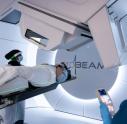A new international study from UCL and UCLH that aims to improve the quality of MRI scans for prostate cancer screening has identified simple ways to treble the number of scans that are of optimal diagnostic quality.
Published in Radiology, the research is an important step towards making MRIs available to all men who need one. Improved MRI imaging will allow clinicians to rule out cancer in more cases without resorting to tissue biopsy, as well as identifying cancer more reliably. Better quality imaging has also been shown to identify the stage a cancer is at more accurately and help make better treatment decisions.
Multiparametric magnetic resonance imaging (mpMRI) of the prostate is now standard of care in patients suspected of having prostate cancer, reducing the need for an upfront tissue biopsy, which is invasive and can lead to complications. As a result, demand for scans has risen sharply. But only scans of the highest quality can rule out cancer without the need for a subsequent biopsy, or rule in cancer to allow biopsies to be accurately directed towards suspicious areas.
Prostate Imaging Quality (PI-QUAL) is the first standardised scoring system that evaluates image quality using a five-point scale, where five means the scan is of optimal quality for diagnosis. The system was developed as part of the UCL-led PRECISION study1, published in 2018, which led to changes in international clinical practice that meant all men now receive an upfront MRI instead of an upfront biopsy. An MRI is quicker, cheaper and less invasive than a tissue biopsy.
To overcome existing capacity issues and to ensure that all men can access an MRI scan, the PRIME trial2 was setup to assess whether an even shorter, cheaper and less invasive MRI scan could become the new standard of care. This latest study, called GLIMPSE, is part of that trial.
In the first phase of GLIMPSE, researchers analysed a total of 355 MRI scans from 41 medical centres across 18 countries. Only 32% achieved the highest PI-QUAL score of five.
The research team provided feedback to the centres to improve the quality of their scans. When 36 centres from 17 countries resubmitted the MRIs, the percentage of scans achieving a PI-QUAL score of five rose to 97%. This quality is essential for ruling out cancer through MRI alone, which cannot be done for scans with a lower PI-QUAL score.
Dr Alexander Ng (UCL Division of Medicine), first author of the study, said: “The beauty of our study is that we have provided a glimpse into the international quality of MRI scanners, and found that only a third of scanners were of optimal diagnostic quality. The quality of MRI scans can be significantly improved by following a few simple recommendations. This could be changing the duration of certain sequences by a few seconds, for example. In terms of impact, we will see a big difference to prostate cancer detection for very little effort and cost.”
The results of the study will feed directly into PRIME. One of the key aims of this trial is to see whether a two-stage MRI scan can be just as effective at diagnosing prostate cancer as the standard three-phase scan. If the trial is successful, it is expected to change clinical practice and has the potential to reduce the time needed to perform an MRI from 30 minutes to 20 minutes on average. It would also require fewer clinical staff, be less invasive without the need for intravenous contrast, and with potential cost-savings for healthcare providers.
Associate Professor Veeru Kasivisvanathan (UCL Division of Surgery & Interventional Science), a senior author of the study, said: “The long-term goal of our work on prostate cancer screening is to see whether we can effectively diagnose or rule out cancer using a shorter, cheaper MRI scan. There is growing awareness amongst cancer specialists that variable quality of MRI scans poses a challenge to this approach, hence the results of the GLIMPSE study are an important step towards making MRI imaging as quick, cheap and effective as possible.”
The PRIME and GLIMPSE studies are funded by Prostate Cancer UK and The John Black Charitable Foundation through a Travelling Prize Fellowship Award, the European Association of Urology Research Foundation and the Dieckmann Prostate Cancer Research Foundation.
Patient experiences
Victor Virchis, 85, was part of the PRIME trial. After being referred to UCLH with suspected prostate cancer, he subsequently underwent a multi parametric MRI of his prostate. The MRI was negative, and reassured his clinical team that he needed no further investigations. As a result, he avoided having to have an invasive biopsy.
Victor said: “The team explained that the normal MRI was a substitute for having a biopsy, and I was very relieved, and I appreciated that. It’s clearly important to have confidence in what you are seeing on the scan and they have been able to show that the quality can be improved by their work.”
Allan Roper, 72, underwent multi parametric MRI as part of another UCL-led trial investigating the role of MRI in prostate cancer detection. He had a multiparametric MRI scan followed by prostate biopsies. The results of the trial allowed a pathway for precise MRI-targeted biopsies to be delivered in patients with abnormal MRIs which increases the chances of the harmful cancers being found.
“When I was told about the trial, it was a no brainer: I was happy to be part of it. Without the diagnostic pathway introduced by the team, I might not be here today, because without it I wouldn’t have known at that time that I had cancer, so wouldn’t have been able to start treatment straight away. To me that just shows the importance of fast, accurate and an early diagnosis. For the PRIME trial, a more concise MRI will mean that more men will be able to get a scan and more will be diagnosed accurately which means less anxiety and the possibility of no biopsy if no cancer is seen.”
Image: Associate Professor Veeru Kasivisvanathan




